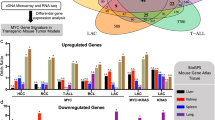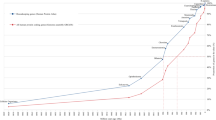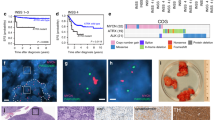Abstract
The myc family of cellular oncogenes contains three known members. The N-myc and c-myc genes have 5′-noncoding exons, strikingly homologous coding regions1–3, and display similar oncogenic potential in an in vitro transformation assay4,5. The L-myc gene is less well characterized, but shows homology to N-myc and c-myc (ref. 6; also see below), c-myc is expressed in most dividing cells, and deregulated expression of this gene has been implicated in the development of many classes of tumours7. In contrast, expression of N-myc has been found only in a restricted set of tumours, most of which show neural characteristics; these include human neuroblastoma8–10, retinoblastoma10,11 and small cell lung carcinoma (SCLC)12. L-myc expression has so far been found only in SCLC6. Activated N-myc and L-myc expression has been implicated in oncogenesis4–6,11,12; for example, although N-myc expression has been found in all neuroblastomas tested9,10, activated (greatly increased) N-myc expression, resulting from gene amplification8,13,14, is correlated with progression of the tumour15. We now report that high-level expression of N- and L-myc is very restricted with respect to tissue and stage in the developing mouse, while that of c-myc is more generalized. Furthermore, we demonstrate that N-myc is not simply a neuroectoderm-specific gene; both N- and L-myc seem to be involved in the early stages of multiple differentiation pathways. Our findings suggest that differential myc gene expression has a role in mammalian development and that the normal expression patterns of these genes generally predict the types of tumours in which they are expressed or activated.
This is a preview of subscription content, access via your institution
Access options
Subscribe to this journal
Receive 51 print issues and online access
$199.00 per year
only $3.90 per issue
Buy this article
- Purchase on Springer Link
- Instant access to full article PDF
Prices may be subject to local taxes which are calculated during checkout
Similar content being viewed by others
References
Kohl, N. E. et al. Nature 3,9, 73–77 (1986).
DePinho, R. et al. Proc. natn. Acad. Sci. U.S.A. (in the press).
Colby, W. W. et al. Nature 301, 722–725 (1983).
Yancopoulos, G. D. et al. Proc. natn. Acad. Sci. U.S.A. 82, 5455–5459 (1985).
Schwab, M., Varmus, H. E. & Bishop, J. M. Nature 316, 160–163 (1985).
Nau, M. M. et al. Nature 318, 69–73 (1985).
Varmus, H. A. Rev. Genet. 18, 553–612 (1984).
Kohl, N. E. et al. Cell 35, 359–367 (1983).
Schwab, M. et al. Proc. natn. Acad. Sci. U.S.A. 81, 4940–4944 (1984).
Kohl, N. E., Gee, C. E. & Alt, F. W. Science 226, 1335–1336 (1984).
Lee, W. H., Murphee, A. L. & Benedict, W. F. Nature 309, 458–460 (1984).
Nau, M. M. et al. Proc. natn. Acad. Sci. U.S.A. (in the press).
Schwab, M. et al. Nature 305, 245–248 (1983).
Michitsch, R. W., Montgomery, K. T. & Melera, P. W. Molec. cell. Biol. 4, 2370–2380 (1984).
Schwab, M. et al. Nature 308, 288–291 (1984).
Nepveu, A., Fahrlander, P. D., Yang, J. & Marcu, K. B. Nature 317, 440–443 (1985).
Whitlock, C. A., Ziegler, S. F., Treiman, L. J., Stafford, J. J. & Witte, O. N. Cell 32, 903–911 (1983).
Carney, D. N. et al. Cancer Res. 45, 2913–2923 (1985).
Gazdar, A. F., Carney, D. N., Nau, M. F. & Minna, J. D. Cancer Res. 45, 2924–2930 (1985).
Becker, K. L. & Gazder, A. F. The Endocrine Lung in Health and Disease (Saunders, Philadelphia, 1984).
Nisen, P. D. et al. EMBO. J. (submitted).
Gonzalez-Crussi, F. (ed.) & Franklin, W. A. in Wilms' Tumour and Related Renal Neoplasms of Childhood, 7 (CRC Press, Boca Raton, 1984).
Yancopoulos, G. D. & Alt, F. W. Cell 40, 271–281 (1985).
Stanton, L. W., Fahrknder, P. D., Tesser, P. M. & Marcu, K. B. Nature 310, 423–425 (1984).
Alt, F. W., Rosenberg, N., Lewis, S., Thomas, E. & Baltimore, D. Cell 27, 381–390 (1981).
Author information
Authors and Affiliations
Rights and permissions
About this article
Cite this article
Zimmerman, K., Yancopoulos, G., Collum, R. et al. Differential expression of myc family genes during murine development. Nature 319, 780–783 (1986). https://doi.org/10.1038/319780a0
Received:
Accepted:
Issue Date:
DOI: https://doi.org/10.1038/319780a0
This article is cited by
-
The MYCN inhibitor BGA002 restores the retinoic acid response leading to differentiation or apoptosis by the mTOR block in MYCN-amplified neuroblastoma
Journal of Experimental & Clinical Cancer Research (2022)
-
Thyroid hormone receptor α controls larval intestinal epithelial cell death by regulating the CDK1 pathway
Communications Biology (2022)
-
Genome-wide expression of the residual lung reacting to experimental Pneumonectomy
BMC Genomics (2021)
-
A direct comparison of selective BH3-mimetics reveals BCL-XL, BCL-2 and MCL-1 as promising therapeutic targets in neuroblastoma
British Journal of Cancer (2020)
-
Calreticulin regulates MYCN expression to control neuronal differentiation and stemness of neuroblastoma
Journal of Molecular Medicine (2019)
Comments
By submitting a comment you agree to abide by our Terms and Community Guidelines. If you find something abusive or that does not comply with our terms or guidelines please flag it as inappropriate.



